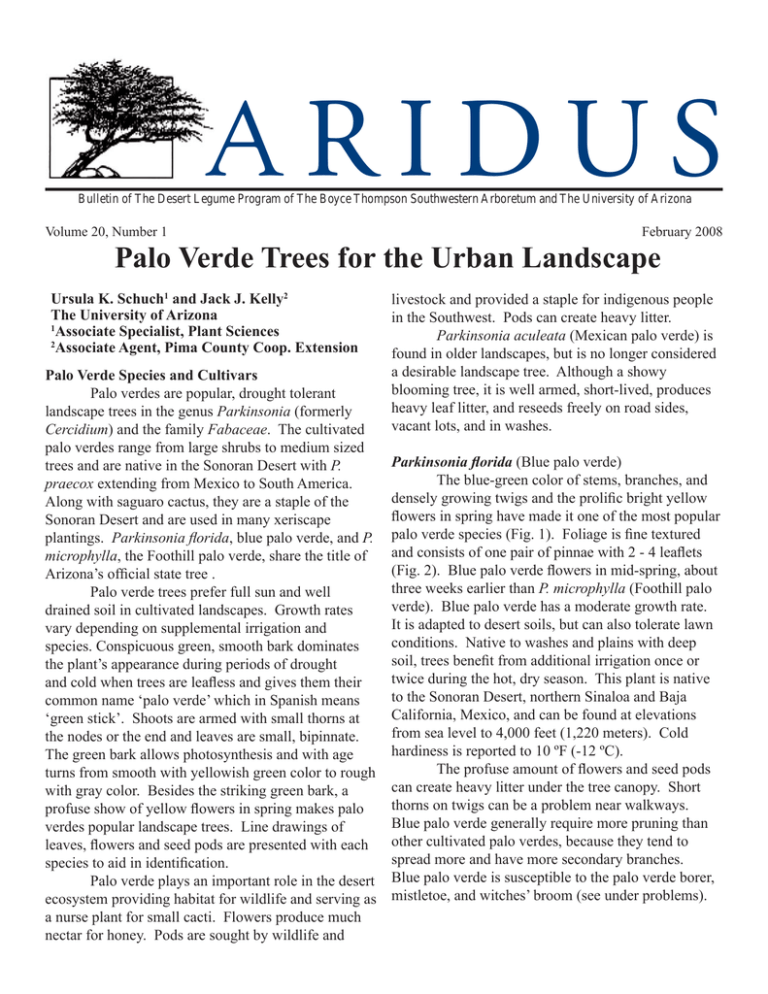Document 10685508
advertisement

A R I D U S Bulletin of The Desert Legume Program of The Boyce Thompson Southwestern Arboretum and The University of Arizona Volume 20, Number 1 February 2008 Palo Verde Trees for the Urban Landscape Ursula K. Schuch1 and Jack J. Kelly2 The University of Arizona 1 Associate Specialist, Plant Sciences 2 Associate Agent, Pima County Coop. Extension Palo Verde Species and Cultivars Palo verdes are popular, drought tolerant landscape trees in the genus Parkinsonia (formerly Cercidium) and the family Fabaceae. The cultivated palo verdes range from large shrubs to medium sized trees and are native in the Sonoran Desert with P. praecox extending from Mexico to South America. Along with saguaro cactus, they are a staple of the Sonoran Desert and are used in many xeriscape plantings. Parkinsonia florida, blue palo verde, and P. microphylla, the Foothill palo verde, share the title of Arizona’s official state tree . Palo verde trees prefer full sun and well drained soil in cultivated landscapes. Growth rates vary depending on supplemental irrigation and species. Conspicuous green, smooth bark dominates the plant’s appearance during periods of drought and cold when trees are leafless and gives them their common name ‘palo verde’ which in Spanish means ‘green stick’. Shoots are armed with small thorns at the nodes or the end and leaves are small, bipinnate. The green bark allows photosynthesis and with age turns from smooth with yellowish green color to rough with gray color. Besides the striking green bark, a profuse show of yellow flowers in spring makes palo verdes popular landscape trees. Line drawings of leaves, flowers and seed pods are presented with each species to aid in identification. Palo verde plays an important role in the desert ecosystem providing habitat for wildlife and serving as a nurse plant for small cacti. Flowers produce much nectar for honey. Pods are sought by wildlife and livestock and provided a staple for indigenous people in the Southwest. Pods can create heavy litter. Parkinsonia aculeata (Mexican palo verde) is found in older landscapes, but is no longer considered a desirable landscape tree. Although a showy blooming tree, it is well armed, short-lived, produces heavy leaf litter, and reseeds freely on road sides, vacant lots, and in washes. Parkinsonia florida (Blue palo verde) The blue-green color of stems, branches, and densely growing twigs and the prolific bright yellow flowers in spring have made it one of the most popular palo verde species (Fig. 1). Foliage is fine textured and consists of one pair of pinnae with 2 - 4 leaflets (Fig. 2). Blue palo verde flowers in mid-spring, about three weeks earlier than P. microphylla (Foothill palo verde). Blue palo verde has a moderate growth rate. It is adapted to desert soils, but can also tolerate lawn conditions. Native to washes and plains with deep soil, trees benefit from additional irrigation once or twice during the hot, dry season. This plant is native to the Sonoran Desert, northern Sinaloa and Baja California, Mexico, and can be found at elevations from sea level to 4,000 feet (1,220 meters). Cold hardiness is reported to 10 ºF (-12 ºC). The profuse amount of flowers and seed pods can create heavy litter under the tree canopy. Short thorns on twigs can be a problem near walkways. Blue palo verde generally require more pruning than other cultivated palo verdes, because they tend to spread more and have more secondary branches. Blue palo verde is susceptible to the palo verde borer, mistletoe, and witches’ broom (see under problems). 2 Figure 1: Profuse bloom on Parkinsonia florida Aridus 20:1 2008 heavier after a wet winter (Fig. 4). P. florida and P. microphylla can be differentiated by their flower colors. P. florida has five deep yellow petals whereas P. microphylla has four yellow and one whitish petal which give the plant an overall pale yellow color while in bloom. Seed pods of P. microphylla are 1.2 – 5 inches (3-13 cm), oblong, and are constricted between seeds (Fig. 3). They can create heavy litter. P. microphylla is native to the Sonoran Desert including Baja California in Mexico. This species requires well drained soil and does not tolerate lawn or well-watered conditions. Although extremely drought tolerant, trees might shed branches during prolonged drought. P. microphylla is tolerant of temperatures to 15 ºF (-9 ºC). Maintenance in the landscape generally includes pruning of dead branches, mistletoe, witches’ broom or to expose lower stems. Similar to blue palo verde, P. microphylla trees are also susceptible to the palo verde borer. Foothill palo verde trees are available in cultivation and large specimens are successfully moved from the wild to developed areas. Figure 2: Leaf, flower and seed pod of Parkinsonia florida Parkinsonia microphylla (Foothill palo verde, littleleaf palo verde) Foothill palo verde trees grow 10 to 20 feet (3 to 6 meters) tall with equal spread. They are the slowest growing species among the Parkinsonia in cultivation. The canopy is dense with spiny branches and bark color is yellowish green. Leaflets are smallest among the species described here; leaves have one pair of pinnae with 4 - 8 pairs of leaflets each and appear on the tree only for a short time after summer or winter moisture in natural settings (Fig. 3). Flowers appear briefly and are pale yellow in color. Intensity of flowering varies by year and is generally Figure 3: Leaf, flower and seed pod of Parkinsonia microphylla Aridus 20:1 2008 3 Figure 4: Parkinsonia microphylla in full bloom Parkinsonia praecox subsp. glauca (Argentine palo brea) This tree grows up to 20 feet (6 meters) tall and originated in Argentina. It has the characteristic green bark, yellow flowers, and tan pods of the genus. It looks very similar to the Sonoran palo brea (P. praecox subsp. praecox) but has smaller leaflets. The subspecies glauca is considered to have greater drought tolerance than the Sonoran palo brea, because it is native in areas that receive as little as 4 inches (80 - 100 mm) of annual rainfall. Supplemental irrigation will increase growth. Argentine palo brea is also thought to have greater cold hardiness to 10 ºF (-12 ºC) based on observations where the Sonoran palo brea suffered greater cold damage after frost than the Argentine palo brea. This open shrub is often trained to a small tree by removing lower limbs and can be used in areas such as medians and patios where space may be limited. No problems have been observed on trees in the landscape. ‘Brea’ is the Spanish word for tar or pitch and refers to the waxy coating of the bark that can be scraped off and used as glue. The exudates from the bark are sweet and edible and have been used to make soap. Medicinal use of bark has been reported. Figure 5: Leaf, flower and seed pod of Parkinsonia praecox subsp. praecox Parkinsonia praecox subsp. praecox (Sonoran palo brea, Brea) This small tree grows 15 to 30 feet (4.5 - 9 meters) tall with almost equal spread. This subspecies has the largest leaflets of the genus (Fig. 5). Flowers are golden yellow, the bark is bright green to lime green with foliage of blue green color. Seed pods are tan colored, oblong and 1.2 – 2.5 inches (3-6) cm in length and can create heavy litter. Growth rate is moderate to rapid and increases with supplemental irrigation. Plants tolerate a wide range of soil conditions. Subspecies praecox is native to the widest range of the genus and occurs from northwest Mexico in disjunct populations as far south as Argentina, and from near sea level to 6,560 feet (2000 meters) elevation. This subspecies is considered less tolerant to drought and cold temperatures than the subspecies glauca. Hardiness of plants from Sonora has been reported at 20 ºF (-6.5 ºC). Hybrids of P. praecox with P. microphylla or P. florida have been observed. 4 Parkinsonia hybrids and cultivars Parkinsonia x ‘Desert Museum’ is the most popular hybrid of the genus and is a natural three- way cross of (P. aculeata x P. microphylla) x P. florida. Desirable horticultural characteristics of this tree include its upright growth habit, no thorns, fast growth with irrigation, smooth light green bark, and large masses of yellow flowers produced from March to May. Leaf size is intermediate between the parent taxa. P. x ’Desert Museum’ has one or two pairs of pinnae that are 2 – 4 inches (5 - 10 cm) in length and 9 - 19 pairs of leaflets per pinna (Fig.6). Trees reach a height of 21 to 25 feet (7 - 8.3 meters) and grow as wide in canopy. The plant is hardy to 15 °F (-9.5 °C). Plants need to be propagated vegetatively to retain the characteristics of the parent tree. Aridus 20:1 2008 Figure 7: Leaf, flower and seed pod of Parkinsonia x sonorae Figure 6: Leaf of Parkinsonia x ‘Desert Museum’ Another palo verde hybrid, Parkinsonia x sonorae (Sonoran palo verde) is a cross of P. microphylla x P. praecox (Fig. 7). This small tree grows 10 to 20 feet (3.3 to 6.3 meters) high and as wide, but is not widely available in the trade. A few other cultivars available in the trade have been selected by nurseries for desirable aesthetic appearance or improved cold hardiness. Culture Palo verde trees are extremely drought tolerant once established, but vary in their tolerance to irrigation. P. florida is most tolerant of the genus of frequently irrigated conditions such as lawns, while P. microphylla does not tolerate frequent irrigation. Even when tolerant of turf conditions, desert trees including palo verde are not recommended in turf. The shallow frequent irrigations to maintain turf can lead to possible tree toppling and loss. In addition, sun-loving grass species such as bermuda grass do not grow well in the shade below the tree. Problems Witches’ broom causes a proliferation of dense twig growth and is associated with mites, but the cause of the problem is unclear at this time (Fig. 8). Removal of affected branches is the only method of control to date, but does not prevent reoccurrence. P. florida (blue palo verde) and P. microphylla (Foothill palo verde) are affected by this disorder. Aridus 20:1 2008 5 The Other “palo verdes” Figure 8: Witches’ broom on palo verde True mistletoe can affect all Parkinsonia species. Control methods were described in the previous issue of Aridus dealing with mesquites. Palo verde root borer (Derobrachus geminatus) is the larval grub stage of the 3 -3.5 inch (8 - 9 cm) palo verde beetle. The adult beetle is dark brown to black and has prominent antennae approximately half the overall length of the insect. The larval stage is up to 5 inches (12.7 cm) in length and attacks the roots of many desert trees including palo verdes. Adult insects emerge from 1 inch (2.5 cm) wide holes in the soil during summer rains. Upon the removal of dead palo verde trees, the grub is usually present in the roots, hence the name. No control measures are recommended. Palo verde webbers (Bryotropha inaequalis) emerge in spring and become apparent because of the silken tubes in which they live. The fine webbing appears soon after leaves emerge after winter rains on P. microphylla. Small caterpillars are up to ½ inch long and slender. References Johnson, M. 1996. Palo verde – a review of the genus Cercidium. Aridus 8(3):1-6. Jones, W. and C. Sacamano. 2000. Landscape Plants for Dry Regions. Fisher Books, Tucson, AZ. Journal of the Arnold Arboretum 57(3, 4): 219-249, 450-525. Acknowledgement Line drawings are courtesy of Matt Johnson. The term palo verde is from Spanish meaning green stick. A variety of woody legumes from both dry and humid climates have photosynthetic bark, especially on younger stems. These stems may remain green for one to several years before losing their photosynthetic ability. In arid regions particularly, some legumes retain their green bark for much longer periods, relying on photosynthesis in the bark to provide the plant’s energy needs during extended dry periods. Most of these plants have small leaves that appear only during periods of favorable soil moisture and are shed as dry conditions return. A few are entirely leafless. Stem-photosynthetic trees and shrubs are found in the caesalpinioid, mimosoid, and papilionoid groups of legumes. Parkinsonia (= Cercidium) are among the best-known examples, and are frequently called palo verdes, with 6 species native to the New World and 4 in Africa. All but the oldest trunks and limbs frequently retain their photosynthetic bark. Geoffroea decorticans, chañar or Chilean palo verde, and G. spinosa from South America and the Caribbean have distinctive green bark that peels into strips and flakes. These trees superficially resemble species of Parkinsonia. Mimosa ephedroides from the Monte Desert of Argentina has numerous green stems and small ephemeral leaves. As the specific epithet suggests, the plants closely resemble species of Ephedra (Ephedraceae). Ramorinoa girolae, endemic to parts of the Monte Desert in western Argentina, is a large shrub with persistent, green twigs and minute, scale-like leaves. Senna aphylla and several related species from the Gran Chaco and Monte Desert regions of southern South America are completely leafless after the seedling stage, relying entirely on their green stems for photosynthesis. In South America, species of Prosopis have gotten in on the act. The densely branched, thick, sharp-tipped twigs of Prosopis kuntzei remain photosynthetic, producing tiny leaves only following wet conditions. Prosopis seriacantha has taken this even further, becoming entirely leafless. The genus Prosopidastrum, with 4 species of shrubs in South America and 1 species from the Baja California peninsula in Mexico, is another group of plants with green stems and small, quickly deciduous leaves. 6 In the deserts of southwestern North America, Psorothamnus includes several species with photosynthetic stems and highly reduced ephemeral leaves. A few of the many Australian acacias including Acacia aphylla, A. continua, and A. genistifolia have green stems that fulfill most or all of the plants’ photosynthetic needs. Bossiaea walkeri is an unusual Australian shrub called cactus pea that has flattened leafless stems that carry out photosynthesis. Adenolobus garipensis, a large shrub from southern Africa, has grayish, photosynthetic twigs and small leaves. Species of Genista and Retama from dry regions of southern Europe, North Africa, and the Middle East have small, early deciduous leaves on photosynthetic stems with some species of Genista being entirely leafless. This brief overview has introduced some of the woody legumes from dry regions that have evolved green bark to meet most or all of their photosynthetic needs. This characteristic is certainly not unique to legumes, being found in dozens of plant families with tree and shrubs species. That it appears so widely does suggest that it is a successful strategy for some plants to meet their needs while conserving moisture and other resources in dry environments. MBJ Aridus 20:1 2008 DELEP Personnel Mark Bierner, Ph. D. Director Matthew B. Johnson Botanical Specialist Ken Coppola Horticulturist Margaret Norem, Ph.D. Editor Aridus Kirsten Lake Floristics Coordinator Bruce Klewer Administrative Assistant Volunteer Coordinators Yuma Fields Glenn Branham Pamela Honaker Jamie Wahl Advisory Board Michael Chamberland Elizabeth Davison David Ellis, Ph.D. Stephanie Greene, Ph.D. Leslie Gunatilaka, Ph.D. Ryan Huxtable, Ph.D. Michelle McMahon, Ph.D. Ken Morrow Pamela Slate Raymond Turner, Ph. D. Prosopidastrum globosum Aridus 20:1 2008 Volunteers Provide DELEP’s Foundation for the Future DELEP’s Advisory Board is scheduled to meet on Friday, February 29th. We welcome Ms. Pamela Slate, Mr. Michael Chamberland, and Dr. Raymond Turner for their willingness to work more closely with DELEP, as new Advisory Board members. Just less than 20 years ago, Dr. R. Philip Upchurch coordinated volunteers from varied professions in science, education, and industry to assemble the beginnings of the Desert Legume Program. Contributing their time and personal resources, a small group started with seed collections and propagation, in hopes of attracting wider attention for desert legumes. During recent months, volunteers have participated in projects similar to those original efforts toward achieving project goals. Twenty years ago, a start was made in constructing primary computer documentation of our seed bank as an ongoing list with standard accession information. These were simple documents with limited potential for manipulation. As computer technology has evolved, we have adopted new means of collecting, storing and sharing DELEP information. An example of this is that our Index Seminum is now available on the web (see http://ag.arizona.edu/BTA/delep). Recently we have upgraded to new computers (also because of your support) which afford a greater ability to interact with a global scientific network. Volunteer Roy Williams has been an important asset to the program, working hundreds of hours on the revision of some of our electronic databases. Roy and Matt have fine-tuned the seed inventory database, and comprehensive field data, from the past several years. These “new” documents apply up-to-date technology, are better for viewing and displaying, and will be easier to expand than previous versions. They will allow an opportunity to present results from years of propagation, plant evaluation, and information collection. Thank you, Roy. Better access to this bounty of knowledge is crucial for our larger current projects like producing the “Legumes of Arizona” volume. New technologies that we are employing will also allow a greater interface of work by floristics coordinator Kirsten Lake, Matt Johnson, Dr. Bierner, To Volunteer: Opportunities for Participation DELEP’s bulletin Aridus, is published three times annually to stimulate interest in desert legumes, inform our readers of DELEP’s activities, and encourage support of DELEP’s programs. Manuscripts related to legumes are welcome and should be mailed to the editor for review. Subscriptions are complimentary and are available by contacting the DELEP office. Aridus is published by The University of Arizona for The Desert Legume Program. Financial support for DELEP is provided by private industries, government agencies and individuals through contracts, grants and contributions. Dedicated volunteer work is an integral component of DELEP. Our volunteers have many different backgrounds and work on various projects including wild seed collecting, seed processing, special events and office tasks. Delep volunteers meet once a month. Call (520) 318-7046 Email: kcoppola@ag.arizona.edu To Contribute: Call to discuss a pledge, restricted gift or estate planning Make a check payable to DELEP/U of A Foundation Mail to Desert Legume Program 2120 E. Allen Road Tucson, AZ 85719 The University of Arizona Desert Legume Program 2120 East Allen Road Tucson, Arizona, 85719 U.S.A. NON-PROFIT ORGANIZATION U.S. POSTAGE PAID PERMIT NO. 190 TUCSON, ARIZONA Return Service Requested the University of Arizona Herbarium, and other contributors working on this landmark volume. Matt is becoming proficient at using Google EARTH capabilities to pin-point coordinates for specific plants and populations where seed collections were made, during DELEP’s many years of collecting. This is an element of technology we welcome, creating an ability to see actual populations and specimens from which collections were made. Use of these technologies will further structure our capacity to have detailed documentation at our fingertips. KC Upcoming volunteer sessions will be on March 12 , April 9th, and May 14th. Please send me an email or call us for more information. th Joe Principi and Terry Donovan in Yuma field (MBJ) Aridus 20:1 2008 8





